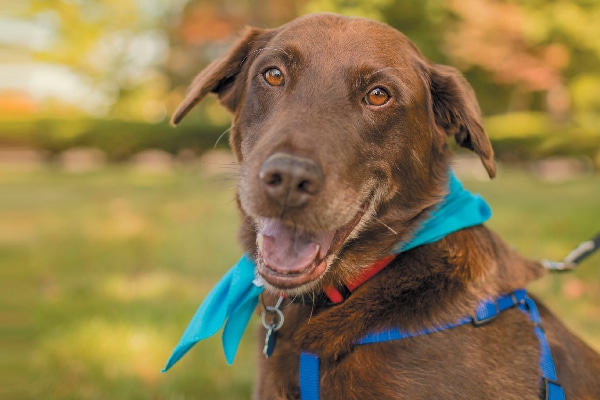For many of my clients, one of the most frustrating things to teach a dog is calm leash or harness walking. There are many reasons that loose-leash walking is a “fail” for dog owners, including:
- Dogs walk faster than we two-legged types.
- Dogs experience the world nose first, and that powerful instrument has them zigging and zagging on walks to follow powerful scents that we can’t smell.
- The dog was never trained how to walk nicely on a leash.
- This canine was never trained to calmly focus on her owner before ever stepping out into the public world.
- The dog has not been socialized to other dogs (or skateboards, bikes, joggers, strollers, etc.,) and thus overreacts by pulling, barking or lunging at stimuli.
How to succeed at loose-leash walking

Happy dog on harness and leash. Photography by Holly Hildreth Photography.
How can we help our dogs learn that we don’t appreciate our arms being ripped from their sockets on daily walks? Here are my top tips. Some might seem counterintuitive, but they work.
1. Train OFF leash first.
I find a quiet, small, indoor space and begin training with focus work first and foremost. I want to be able to control the environment, and I want to be the most exciting element in the room.
2. In your controlled space, richly reward (high-value meat or cheese training treats) your dog for visually checking in with you.
Any behavior you reward will increase, and you want to create this bond and this habit of checking in with your dog from the get-go. Put this on cue — say your dog’s name, and mark her head turn and eye contact with “Yes!” and a treat. Do this until you get 80 percent reliability in that enclosed space. Then, and only then, move to other spaces.
3. Richly reward your dog for coming toward you on her own.
You could walk to the closed door of the room when your dog checks out or gets busy smelling something. Your dog will likely get excited to be able to go out and will come trotting or galloping over to you and the door. When she does, praise and take a few steps back while using your cue word “Come” or “Here.” Every time (in the beginning) she comes to you, praise and treat.
4. Once you have solid eye contact and a good recall, then bring out a leash or harness.
I prefer harnesses, as they do not damage the sensitive neck area and no, they do not encourage or teach your dog to pull. Show your dog the harness and reward her curiosity and investigation of it. Next begin to acclimate your dog to a harness being put on — go slowly and go at your dog’s pace. Be relaxed and happy as you set about this training because you want your dog to have a happy association with her harness.
5. Once the harness is on your dog — and your dog is content with it — walk around your enclosed space without a leash attached.
Repeat reinforcing eye contact and coming to you. Next introduce the leash, then attach it once your dog is comfortable with it. At this point, I use my treats to train the dog to stay beside me and to not lunge ahead of me. I do so by dropping a tasty morsel by my left foot. The dog moves in to gobble it up, and I take a few short steps forward. The dog catches up and is looking up at me because I have previously trained eye contact. I say “Yes!” and drop another treat to my left foot. The dog eats while I am stepping forward. Every time she catches up, I show excitement and mark it with a “Yes!” The dog learns in very short order that being beside me is a wonderful place to be.
6. If the dog does surge ahead, I stop.
And I wait a second or two. The dog gets curious and looks back at me, and I mark that with a “Yes!” and turn and go the other direction. When the dog catches up with me, I begin anew the food drop to my left foot, etc.
7. As the dog begins to understand and offer a high rate of reliability …
I back off the treats and use praise and excitement to let the dog know she’s done a great thing. I still carry treats and keep them in the rotation now and again — all of us need motivation!
When are you ready to bring loose-leash walking everywhere?
Once you have mastered turns and gait changes in your enclosed space, take the training to a fenced yard area. Once that is 80 percent proficient, then you are finally ready for the world at large — but even then, be prepared to train your dog as to what you expect of her. And remember: Rewarded behavior increases!
Tell us: Has your dog mastered loose-leash walking? What were your secrets to success?
Annie Phenix, CPDT-KA, is a professional dog trainer based in Utah. She is a force-free trainer specializing in working with troubled dogs. She is the author of The Midnight Dog Walkers: Positive Training and Practical Advice for Living with Reactive and Aggressive Dogs. For more information, visit phenixdogs.com.
Thumbnail: Photography ©Gemma DiLullo | Getty Images.
Editor’s note: This article first appeared in Dogster magazine. Have you seen the new Dogster print magazine in stores? Or in the waiting room of your vet’s office? Subscribe now to get Dogster magazine delivered straight to you!
Read more about dog training on Dogster.com:
- Creating the Perfect Dog Playdate
- How to Prevent Dog Bites
- What Are Dogs Scared Of? How to Help Dogs Overcome Their Fears
The post 7 Steps to Succeed at Loose-Leash Walking appeared first on Dogster.
No comments:
Post a Comment